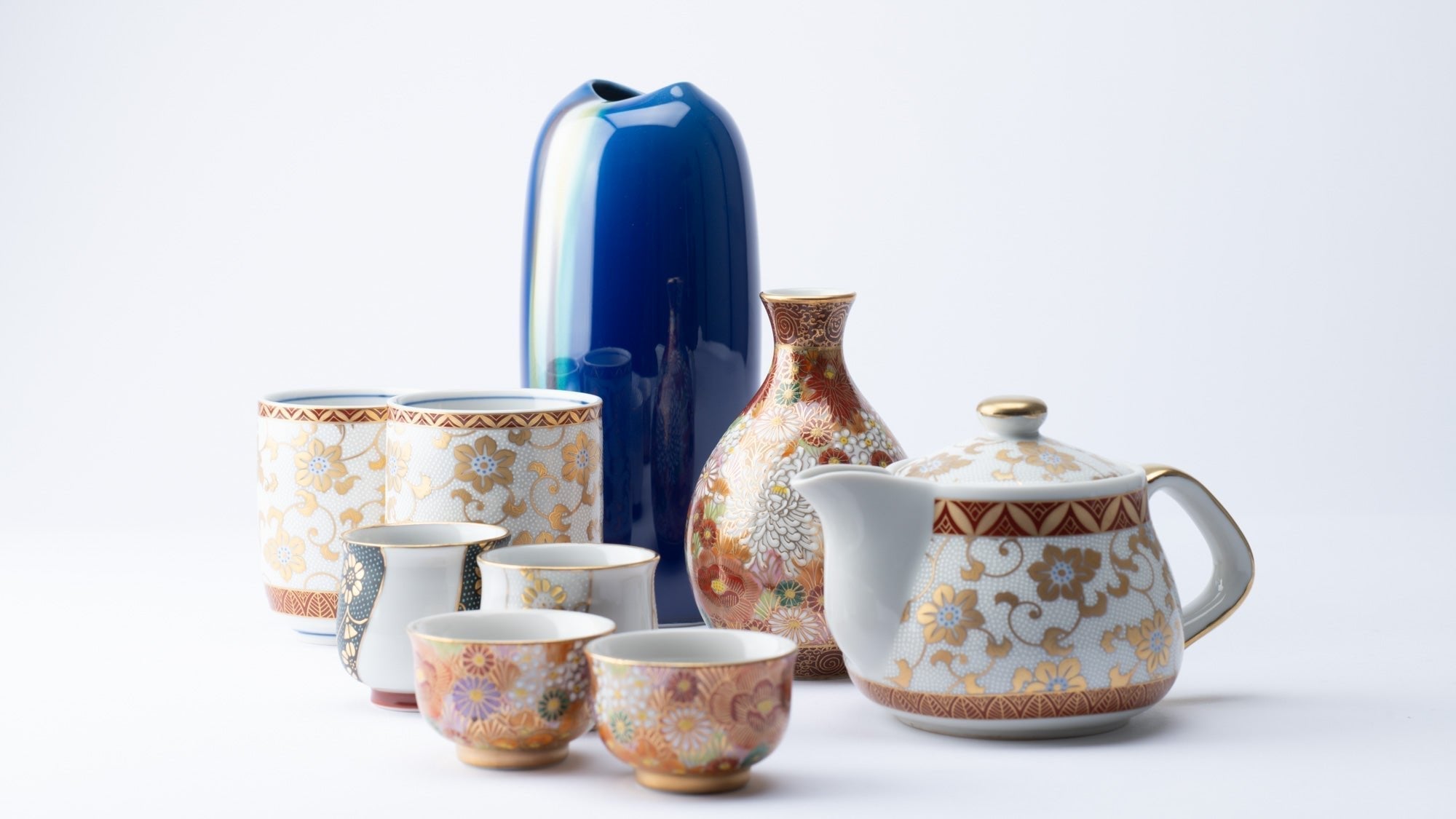
Kutani Ware Styles Born from Japan's Modernization
Written by Team MUSUBI
Kutani ware, characterized by its vivid designs, has undergone changes over the 360 years since its birth–incorporating a variety of cultures.
This article introduces seven Kutani ware styles that have emerged in the course of Japan's modernization and internationalization from the Meiji period (1868-1912) onward.
To learn more about the history of Kutani ware, please click below.
table of contents
The Colorful and Flowery Hanazume Style


The Hanazume style covers pottery pieces with many kinds of flowers. After its first firing, the flowers are further outlined in gold and fired again. The elegant colors and gorgeous overglaze decoration are very popular.
Beautiful and Gold Yuri-kinsai

Yuri-kinsai is a production technique in which a pattern is painted onto a pottery piece using gold leaf, gold paint, or other gold pigments, glazed over, and fired. Unlike the Kirande technique, in which gold is painted using a brush, gold leaf of varying thicknesses is cut out along the lines of a picture or pattern, pasted onto the pottery piece, and then glazed over with a transparent glaze before firing. The thin and difficult-to-handle material of gold leaf cannot be shaped and expressed without skillful technique.

Sophisticated and Silver Yuri-ginsai

Transparent pigments and Kutani Gosai are used for the glaze. Unlike gold, which has a powerful sparkle and presence, silver has a subtle luster and exudes profound beauty. Because of its subtlety, the silver blends beautifully with colored glazes, offering a refined beauty. Typically, silver oxidizes and turns black, but covering it with a glaze prevents oxidation. Another advantage of Yuri-ginsai is that pieces of beautiful silver leaf can be enjoyed for a long time.
Finely-Dotted Aochibu


Aochibu (blue dots) is a technique in which a pattern painted on an even base of black paint is struck with a tool called an “Icchin” to create numerous raised dots. It is extremely difficult to draw small dots of the same size without losing the collective beauty of the entire pattern. The pattern as a whole creates a beautiful appearance of ripples. The smaller the dots are, the more skillful the craftsman is. In addition to Aotsubu, there are also techniques in different colors such as Shirochibu (white dots) and Kinchibu (gold dots).
The Jewel-Like Luster of Saiyu

Saiyu (colored glazing) evokes the unlimited possibilities of Kutani Gosai (red, green, yellow, purple, and navy blue). The expression of the glaze changes depending on the reflection of light, which creates a jewel-like luster on the surface of pottery pieces.
The application of glaze to the surface of pottery pieces is called Saiyu–a technique that expresses beauty not through patterns but through color itself. The glaze applied to the base material becomes glassy when fired, which gives the colored porcelain's surface its luster.
Saiyu uses a technique that involves mixing colored glazes and applying different shades to a pottery piece's base, creating not only luster but also a beautiful gradation of colors on a piece of pottery's surface. While overglaze painting is generally done at low firing temperatures of around 500-800℃ (982-1472℉), the firing of Saiyu porcelain is done at medium firing temperatures of 1,040℃ (1904℉).
Fine and Detailed Mohitsu Saiji



After the Meiji period (1868-1912), Mohistsu Saiji developed independently in the southern region of Ishikawa Prefecture as a form of expression that complimented the delicate painting techniques of Kutani ware. There are many pieces with writing on the inside of the vessel– surprising its viewers with a high level of craftsmanship. The glaze for the writings contain manganese and is very sticky. This makes it possible to write fine and beautiful characters.
Unique and Alluring Ceramic Sculptures

Kutani ware sculptures are very expressive and warm. These sculptures look so animated, it's almost as if they have a soul.
Ceramic sculpting is a technique of forming people, Buddha, animals, and lucky charms out of clay. This technique has been used in Kutani ware since the Meiji period (1868-1912). The production process involves sculpting a clay mold and then creating the sculpture by hand. Facial expressions and poses are largely determined by the artist's sculpting skills and sense of style. This enables you to enjoy both the attention to detail and the rich colors of Kutani ware.

















Leave a comment
This site is protected by hCaptcha and the hCaptcha Privacy Policy and Terms of Service apply.